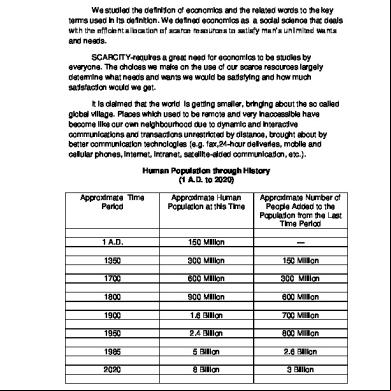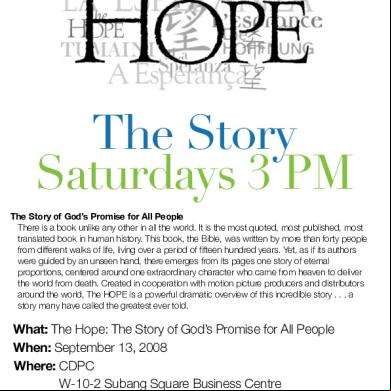The Central Concept Of Economics 4x151j
This document was ed by and they confirmed that they have the permission to share it. If you are author or own the copyright of this book, please report to us by using this report form. Report 3b7i
Overview 3e4r5l
& View The Central Concept Of Economics as PDF for free.
More details w3441
- Words: 632
- Pages: 4
THE CENTRAL CONCEPT OF ECONOMICS We studied the definition of economics and the related words to the key used in its definition. We defined economics as a social science that deals with the efficient allocation of scarce resources to satisfy man’s unlimited wants and needs. SCARCITY-requires a great need for economics to be studies by everyone. The choices we make on the use of our scarce resources largely determine what needs and wants we would be satisfying and how much satisfaction would we get. It is claimed that the world is getting smaller, bringing about the so called global village. Places which used to be remote and very inaccessible have become like our own neighbourhood due to dynamic and interactive communications and transactions unrestricted by distance, brought about by better communication technologies (e.g. fax,24-hour deliveries, mobile and cellular phones, internet, intranet, satellite-aided communication, etc.). Human Population through History (1 A.D. to 2020) Approximate Time Period
Approximate Human Population at this Time
Approximate Number of People Added to the Population from the Last Time Period
1 A.D.
150 Million
---
1350
300 Million
150 Million
1700
600 Million
300 Million
1800
900 Million
600 Million
1900
1.6 Billion
700 Million
1950
2.4 Billion
800 Million
1985
5 Billion
2.6 Billion
2020
8 Billion
3 Billion
This table clearly indicates and simplifies the problem facing all of us today that of an exponentially growing world population, in a single living and liveable planet. The question remains: Where do we get the resources to sustain all these people? The reality of the matter is that population keeps growing as do human wants and needs and yet, resources remain limited. How then do we reconcile something limited with something unlimited? Consider the simple diagram below to better appreciate scarcity.
Wants & Needs
Wants & Needs
Wants & Needs
Wants & Needs
Wants & Needs
In
In
In
In
In
1 A.D.
1985
2050
20XX
21XX
- supposed that this square represents all resources that planet Earth can offer.
-suppose that these rectangles represent the amount of resources being demanded by people in the planet in a given time period. This diagram may not be realistic, but it points out fact that resources are scarce, and that needs and wants continues to grow (even if population should stop growing, as in some countries). There is only a limited amount of resources that could be offered at this time, while human wants and needs continue to grow. Scarcity as an issue does not only pertain to resources that are used to produce goods and services. It also pertains to other various resources, such as financial resources (capital) in a business enterprise, the aim of which is to maximize its resources to make profit. It may also pertain to the daily; weekly or monthly limited allowances and budgets of students. Scarcity remains to be a fact of everyday life, making economics a necessary body of knowledge that everybody should be able to learn. This is why there is a need to “economize” whatever resource we have.
MANAGING SCARCITY Scarce Key Use(s) of this Resource That Scarce Resource Need to be Managed 1) Fossil a) Transportation Fuels b) Manufacturing ( crude oil, plants coal) c) Electric power
Substitute Resource(s) that May be Used a) Biogas b) Solar energy c) Wind power
Alternative Measures to Better Manage the Resource a) Energy – saving devices (Power Booster) b) Daylight saving time(DST) c) Energysaving practices (putting off lights when not needed)
This kind of thing and activities help reduce shortage or “SCARCITY”.
SURIGAO DEL SUR STATE UNIVERSITY Tagbina Campus Tagbina, Surigao Del Sur
COLLEGE OF AGRICULTURAL SCIENCES AND TECHNOLOGY THE CENTRAL CONCEPT OF ECONOMICS
Compilation Requirements in Econ.1
: Bosque, Kate Marbie J. Veras, Glorialyn P. BAT 3B
Submitted to:
October 2017
Approximate Human Population at this Time
Approximate Number of People Added to the Population from the Last Time Period
1 A.D.
150 Million
---
1350
300 Million
150 Million
1700
600 Million
300 Million
1800
900 Million
600 Million
1900
1.6 Billion
700 Million
1950
2.4 Billion
800 Million
1985
5 Billion
2.6 Billion
2020
8 Billion
3 Billion
This table clearly indicates and simplifies the problem facing all of us today that of an exponentially growing world population, in a single living and liveable planet. The question remains: Where do we get the resources to sustain all these people? The reality of the matter is that population keeps growing as do human wants and needs and yet, resources remain limited. How then do we reconcile something limited with something unlimited? Consider the simple diagram below to better appreciate scarcity.
Wants & Needs
Wants & Needs
Wants & Needs
Wants & Needs
Wants & Needs
In
In
In
In
In
1 A.D.
1985
2050
20XX
21XX
- supposed that this square represents all resources that planet Earth can offer.
-suppose that these rectangles represent the amount of resources being demanded by people in the planet in a given time period. This diagram may not be realistic, but it points out fact that resources are scarce, and that needs and wants continues to grow (even if population should stop growing, as in some countries). There is only a limited amount of resources that could be offered at this time, while human wants and needs continue to grow. Scarcity as an issue does not only pertain to resources that are used to produce goods and services. It also pertains to other various resources, such as financial resources (capital) in a business enterprise, the aim of which is to maximize its resources to make profit. It may also pertain to the daily; weekly or monthly limited allowances and budgets of students. Scarcity remains to be a fact of everyday life, making economics a necessary body of knowledge that everybody should be able to learn. This is why there is a need to “economize” whatever resource we have.
MANAGING SCARCITY Scarce Key Use(s) of this Resource That Scarce Resource Need to be Managed 1) Fossil a) Transportation Fuels b) Manufacturing ( crude oil, plants coal) c) Electric power
Substitute Resource(s) that May be Used a) Biogas b) Solar energy c) Wind power
Alternative Measures to Better Manage the Resource a) Energy – saving devices (Power Booster) b) Daylight saving time(DST) c) Energysaving practices (putting off lights when not needed)
This kind of thing and activities help reduce shortage or “SCARCITY”.
SURIGAO DEL SUR STATE UNIVERSITY Tagbina Campus Tagbina, Surigao Del Sur
COLLEGE OF AGRICULTURAL SCIENCES AND TECHNOLOGY THE CENTRAL CONCEPT OF ECONOMICS
Compilation Requirements in Econ.1
: Bosque, Kate Marbie J. Veras, Glorialyn P. BAT 3B
Submitted to:
October 2017










